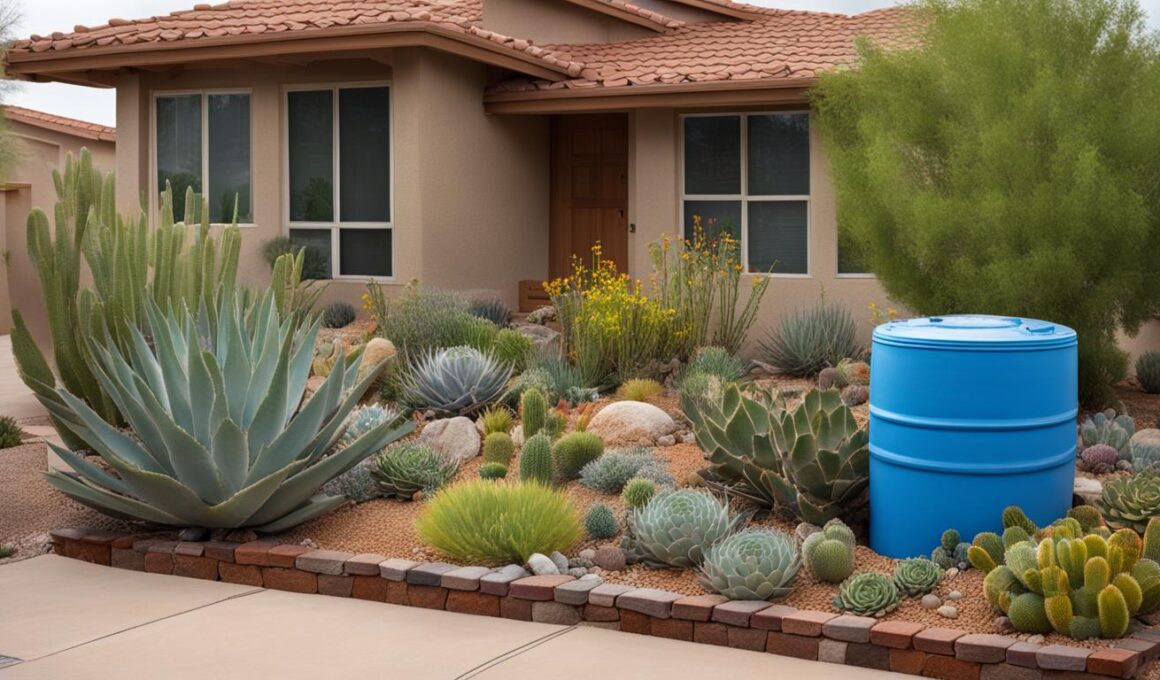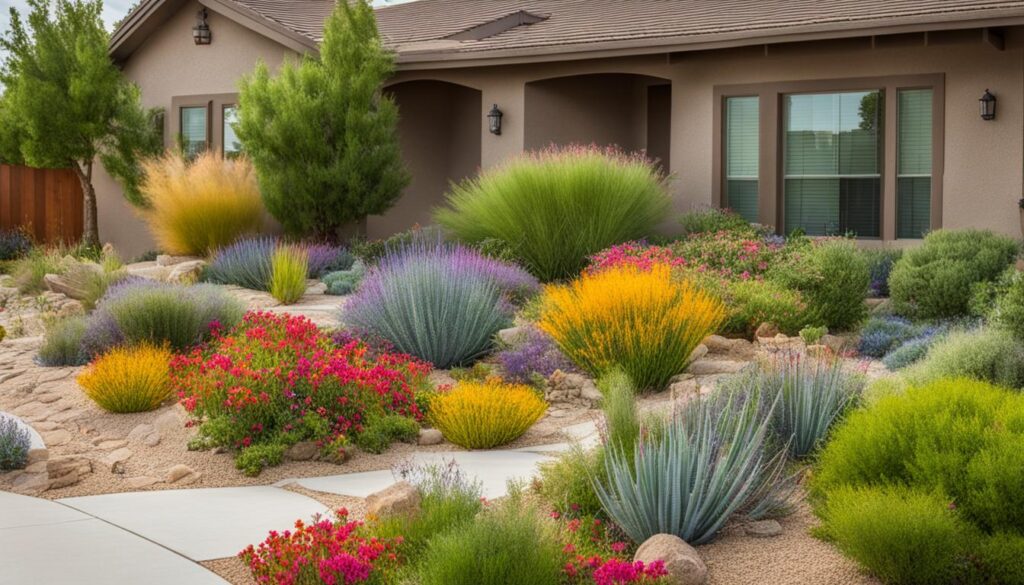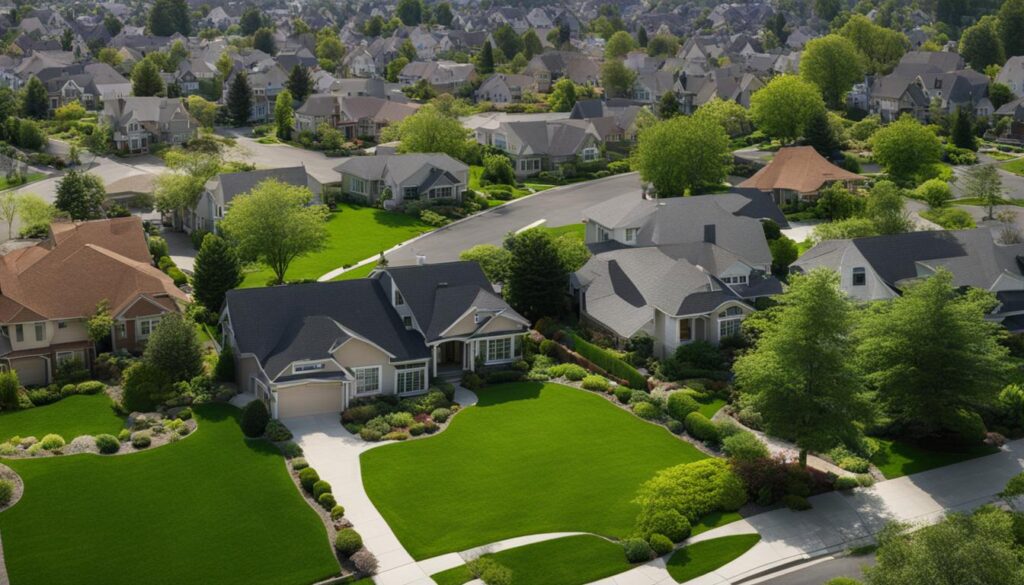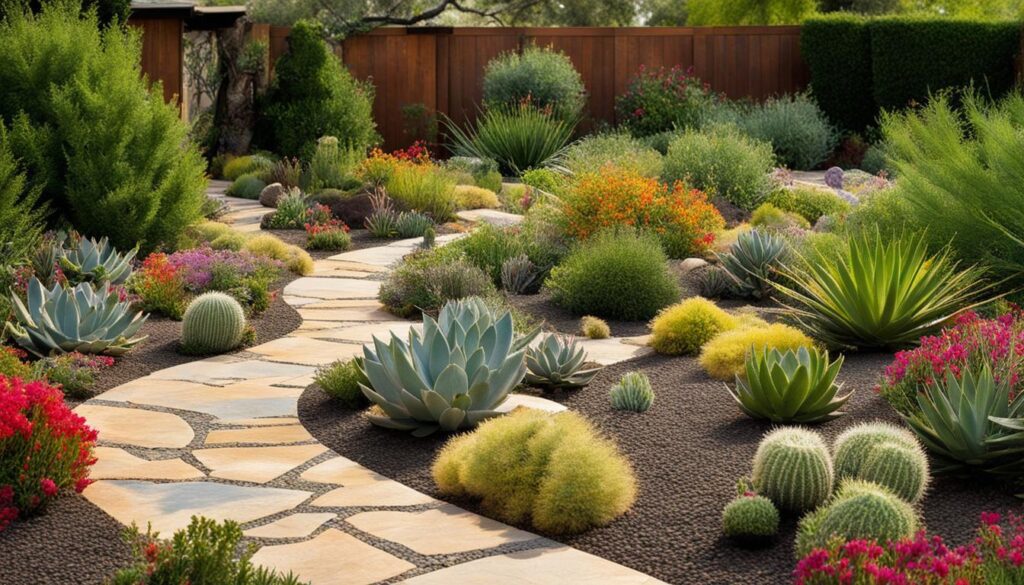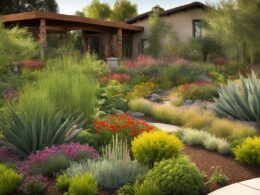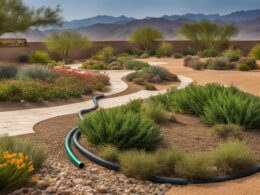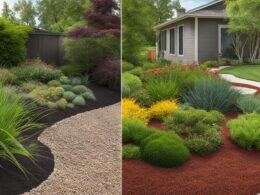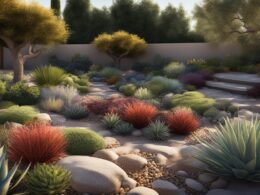Converting to xeriscaping in suburban areas is gaining popularity due to the need to save money, minimize environmental impact, and combat climate change-induced heat waves and droughts. Xeriscaping, which means “dry-scaping” in Greek, is an alternative landscaping method that aims to use as little water as possible while still maintaining aesthetically pleasing and eco-friendly landscaping. It involves using native plants, rocks, and pebbles, as well as no-mow grasses and local flowers, depending on the region’s climate and water supply. Xeriscaping can help reduce water usage, conserve resources, and create beautiful and sustainable green spaces in suburban neighborhoods.
Key Takeaways:
- Xeriscaping is a water-efficient landscaping method gaining popularity in suburban areas.
- It helps save money, minimize environmental impact, and combat climate change-induced heat waves and droughts.
- By using native plants and efficient irrigation methods, xeriscaping reduces water usage and creates sustainable green spaces.
- Xeriscaping eliminates the need for excessive lawn maintenance, such as mowing, fertilizing, and pesticide applications.
- Implementing xeriscaping techniques can contribute to water conservation efforts and enhance the overall quality of suburban neighborhoods.
The Benefits of Xeriscaping in Suburban Areas
Xeriscaping offers several benefits for suburban areas. Firstly, it helps reduce water consumption significantly compared to traditional grass lawns, which can use an estimated 40 to 60 percent of a household’s total water use. By using native and drought-tolerant plants, xeriscaping can thrive with minimal to no additional watering beyond rainfall. This not only saves water but also reduces water bills for homeowners.
Xeriscaping also requires less maintenance, as it eliminates the need for mowing, fertilizing, and pesticide applications. This means less time and effort spent on yard work, allowing homeowners to enjoy their outdoor spaces without constant upkeep. Additionally, xeriscaped yards contribute to the conservation of natural resources, preservation of habitat for local wildlife, and reduction of pollution and carbon emissions from gas-powered lawn equipment.
By choosing xeriscaping in suburban areas, you can not only create beautiful and sustainable green spaces but also make a positive impact on the environment and your community. With its water-saving and low-maintenance qualities, xeriscaping is a smart and eco-friendly choice for creating a visually appealing landscape in suburban neighborhoods.
Xeriscaping in Water-Strained Western States
Western states, particularly those heavily reliant on the Colorado River, are facing severe water shortages and the urgent need to reduce water consumption. In response to this pressing issue, many homeowners in water-strained Western states have turned to xeriscaping as a sustainable and water-efficient landscaping method.
Xeriscaping allows homeowners to create visually appealing yards while minimizing water requirements. By replacing traditional grass lawns with native and drought-tolerant plants, xeriscaping can thrive with minimal additional watering beyond natural rainfall. This not only helps conserve water but also alleviates the strain on already limited water resources in these regions.
Implementing xeriscaping techniques in water-strained Western states provides numerous benefits. It offers a practical solution to reduce water consumption and mitigate the impact of droughts. Additionally, xeriscaped landscapes contribute to the preservation of natural habitats for local wildlife and help minimize pollution and carbon emissions associated with gas-powered lawn equipment. By embracing xeriscaping, homeowners in water-strained Western states can actively participate in water conservation efforts and contribute to the sustainability of their communities.
The Environmental Impact of Traditional Grass Lawns
Traditional grass lawns have a significant environmental impact, with implications for water usage, pollution, and biodiversity. Understanding the negative consequences of grass lawns can help homeowners make more informed choices about their landscaping options.
One of the primary environmental concerns associated with grass lawns is their high water consumption. On average, grass lawns account for approximately 30% of a household’s total water usage, putting strain on local water sources, especially in areas facing droughts and water shortages. By contrast, xeriscaping can significantly reduce water consumption, offering a more sustainable alternative that helps conserve this valuable resource.
In addition to water usage, grass lawns contribute to pollution through the use of nitrogen fertilizers. Excessive application of fertilizers can lead to runoff, which can contaminate bodies of water and cause harmful algae blooms. This not only affects water quality but also disrupts aquatic ecosystems. By adopting xeriscaping techniques, homeowners can minimize or eliminate the need for fertilizers, reducing the risk of pollution and protecting local waterways.
The Origins and Evolution of Grass Lawns
Grass lawns, as we know them today, have an interesting history that dates back to European colonization and the introduction of European grasses to replace native grasses in New England. The concept of grass lawns gained popularity after World War II when it was used as a marketing gimmick to sell the American dream. However, the origins of grass lawns can be traced back even further, with evidence of ornamental grass gardens in ancient Persia and formal lawns in Renaissance Europe.
Over time, grass lawns have evolved from simple areas of mowed grass to meticulously maintained landscapes. The idea of having a perfectly manicured lawn became a symbol of wealth and prestige. However, in many regions, grass lawns are not sustainable due to water scarcity, climate change, and environmental concerns.
“The idea of a lawn is sort of a myth about America, the idea that we have these beautiful green lawns everywhere. But that’s a relatively new concept in human society. It’s not ancient at all.”
The Rise of Xeriscaping
In recent years, the drawbacks of traditional grass lawns have led to the rise of xeriscaping as an alternative landscaping method. Xeriscaping, which means “dry-scaping” in Greek, focuses on using native plants, rocks, and pebbles to create aesthetically pleasing and water-efficient landscapes. By embracing xeriscaping, homeowners can create beautiful and sustainable green spaces without the need for excessive watering and maintenance.
Xeriscaping not only conserves water but also reduces water bills, requires minimal maintenance, and supports local ecosystems. It offers a more environmentally friendly and economically viable option for suburban areas, especially those facing water scarcity and climate challenges. With its origins deeply rooted in the need for sustainable landscaping practices, xeriscaping is a way to reimagine and transform suburban landscapes for a greener future.
Implementing Xeriscaping Techniques in Suburban Landscapes
Implementing xeriscaping techniques in suburban landscapes can help you create a beautiful, environmentally friendly, and water-efficient yard. By following these steps, you can transform your outdoor space into a sustainable oasis:
- Plan and design: Start by assessing your local climate and water availability. This information will guide your plant selection and layout. Consider factors such as sunlight exposure, soil conditions, and water sources.
- Soil analysis and improvement: Conduct a soil analysis to determine its composition and nutrient levels. Based on the results, you may need to amend your soil with organic matter or other additives to improve its quality and drainage.
- Choose appropriate plants: Select native and drought-tolerant plants that are well-suited for your region. These plants require less water and are more resilient to local climate conditions. Incorporate a variety of colors, textures, and heights to create visual interest.
- Efficient irrigation: Install an irrigation system that delivers water directly to the plant roots and minimizes evaporation. Drip irrigation or soaker hoses are effective options. Use a timer to regulate watering schedules and optimize water conservation.
- Use of mulches: Apply a layer of organic mulch around your plants to retain moisture, suppress weeds, and regulate soil temperature. Mulch also adds an aesthetic element to your landscape.
- Appropriate maintenance: Regular maintenance is important for the long-term success of your xeriscaped yard. Prune plants as needed, remove weeds, and monitor for pests. Adjust irrigation schedules based on seasonal changes and plant needs.
Implementing these xeriscaping techniques will not only reduce your water consumption but also save you time and money on maintenance. Your suburban landscape will become a sustainable haven that supports local ecology and enhances the overall beauty of your neighborhood.
Quote:
“Xeriscaping is a practical and environmentally responsible choice for suburban homeowners. By implementing water-efficient techniques, you can create a stunning landscape that saves resources and enhances the beauty of your outdoor space.” – Landscaping Expert
How Can Xeriscaping Be Implemented in Suburban Areas with Limited Space?
Implementing xeriscaping tips for limited areas in suburban spaces involves using low-water plants, installing efficient irrigation systems, and mulching to retain moisture. Grouping plants with similar water needs and utilizing drought-tolerant grasses can also maximize water conservation in smaller yards. Consider xeriscaping to create sustainable and beautiful suburban landscapes.
The Economic and Environmental Benefits of Xeriscaping
Xeriscaping offers numerous economic and environmental benefits. By reducing water consumption, homeowners can see significant savings on their water bills. This is particularly beneficial in suburban areas where water scarcity is a concern. With xeriscaping, you can create a beautiful and sustainable landscape that requires minimal watering beyond natural rainfall. This not only saves water but also reduces the need for costly irrigation systems.
Another economic advantage of xeriscaping is the reduction in maintenance costs. Traditional grass lawns require regular mowing, fertilizing, and pest control, all of which can add up over time. By transitioning to xeriscaping, you eliminate the need for these time-consuming and expensive tasks. Your yard will require less maintenance, giving you more free time to enjoy your outdoor space without the hassle of constant upkeep.
From an environmental perspective, xeriscaping has numerous benefits. By using native and drought-tolerant plants, you are conserving water resources and reducing the strain on local water supplies. Additionally, xeriscaping eliminates the need for harmful chemical fertilizers and pesticides, which can pollute water sources and harm local ecosystems. By creating a xeriscaped yard, you are contributing to the preservation of natural habitats and promoting a healthier environment for both humans and wildlife.
“Xeriscaping not only saves you money on your water bills but also reduces maintenance costs and promotes a healthier environment.”
Furthermore, xeriscaping can increase property values. The growing interest in eco-friendly and sustainable practices has made xeriscaping an attractive feature for potential buyers. A well-designed and well-maintained xeriscaped yard can enhance the curb appeal of your home and set it apart from others in the neighborhood. This can translate into higher property values and a greater return on investment when it comes time to sell.
Summary:
- Xeriscaping reduces water consumption and saves money on water bills.
- It eliminates the need for costly maintenance tasks associated with traditional grass lawns.
- Xeriscaping promotes water conservation, protects natural habitats, and reduces pollution.
- It can increase property values by enhancing curb appeal and attracting eco-conscious buyers.
Conclusion
In conclusion, xeriscaping in suburban areas offers a wide range of benefits for homeowners and the environment. By converting to xeriscaping, you can conserve water and reduce your water bills significantly. The use of native and drought-tolerant plants, along with efficient irrigation methods, helps create visually appealing landscapes that require minimal watering.
Not only does xeriscaping save you time and money on maintenance, but it also contributes to the preservation of natural resources and the reduction of pollution. By eliminating the need for gas-powered lawn equipment and nitrogen fertilizers, xeriscaping helps protect the air quality and water bodies in your community.
With xeriscaping, you can create a sustainable and eco-friendly suburban environment that attracts and supports local wildlife. Additionally, xeriscaping can increase the value of your property by creating an attractive and low-maintenance landscape.





